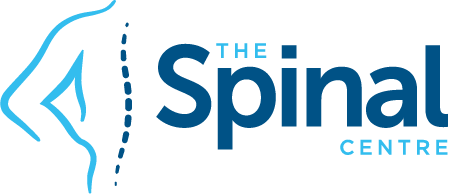
The Anatomy of Back Pain
As you can see from the image below, your back, or spine, is made up of many parts. First, we’re going to look at the bone structures. Your backbone, also called your vertebral column, helps support a lot of your body weight, and it protects your spinal cord. You have 33 vertebrae (bones) that make up the vertebral column. In the image, they’re labeled as “Vertebral Body.”

Parts of the Spine
Your spine is divided into regions: there’s your neck (cervical spine), mid-back (thoracic spine), and low back (lumbar spine). At the bottom of your spine, you also have the sacrum and the coccyx, which is commonly called your tailbone.
The vertebrae in your neck are labeled C1-C7, meaning that you have seven vertebrae in that region. Most adults have 12 vertebrae in the thoracic spine (T1-T12), which goes from your shoulders to your waist. Then there are five vertebrae in your low back (L1-L5), and below that, your sacrum is made up of five vertebrae between the hipbones. By the time you’re an adult, these five bones have fused into one bone. The coccyx is made of small fused bones at the very tail of your spine (hence the tailbone).
Your spine also has facet joints, which are on the posterior side (back) of your vertebrae. These joints (like all joints in your body) help facilitate movement and are very important to your flexibility.
Another vertebral bone structure that’s labeled in the image is the pedicle. These are on either side of your vertebrae, and they are part of the “walls” for your spinal canal.
In between your vertebrae, you have intervertebral discs (also labeled on the image). These act like pads or shock absorbers for your spine as it moves. Each disc is made up of a tire-like outer band called the annulus fibrosus and a gel-like inner substance called the nucleus pulposus.
Together, the vertebrae and the discs provide a protective tunnel (the spinal canal) to house the spinal cord and spinal nerves. These nerves run down the center of the vertebrae and exit to various parts of the body, where they help you feel and move.
Your back also has muscles, ligaments, tendons, and blood vessels. Muscles are strands of tissues that act as the source of power for movement. Ligaments are the strong, flexible bands of fibrous tissue that link the bones together, and tendons connect muscles to bones and discs. Blood vessels provide nourishment. These parts all work together to help you move.
Back pain may be a result of injury to any or all of these body parts. Injury to the muscles, ligaments, tendons can result in sprains or strains, which are generally not considered serious. However, injury to bones, nerves, or blood vessels may be more serious. Also, the outer layers of the intervertebral discs can get tears or cracks, allowing the annulus fibrosus or nucleus pulposus to bulge out. Any of these injuries can cause inflammation and pain.





